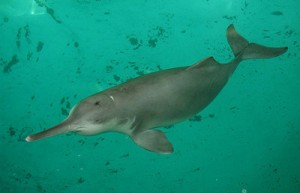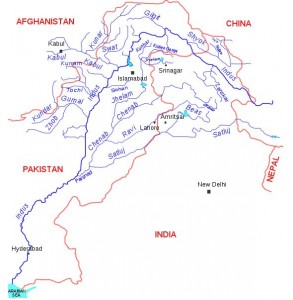After travelling through Tibet and India, the Indus River serves as the lifeline of Pakistan. It is essential for drinking water and farming, not to talk of its crucial role in maintaining the ecosystem of a large section of the country.
But now the erratic and depleting flow of water in theIndus, particularly in the lower stretch of the river, has resulted in irreversible damages to the ecosystems. Many of the indigenous flora and fauna of the region are already extinct.
The significant upstream water and sediment blockage by dams in the upper stretches of the river means that most years the Indus does not even reach the Arabian Sea. The river’s appearance at the Thatta-Sajawal Bridge in southern Sindh province seems to be only a wide strip of leftover rainwater. This has severely degraded the delta ecosystem. It has also led to over-exploitation of groundwater and degradation in water quality.
The Indusis home to 25 amphibian species and 147 fish species of which 22 are found nowhere else in the world. It harbours the endangered Indus River Dolphin, one of the world’s rarest mammals, says a WWF report called World’s Top 10 Rivers at Risk.
The Indus provides 80% of all the water consumed in Pakistan, according to Pakistan Water Gateway. More than 70% of water in Indus comes from glaciers and high altitude wetlands. It has a total drainage area of over one million square kilometres, most of which is in Pakistan. Its annual flow is 207 billion cubic metres, which is twice as that of Nile and three times that of the Tigris and Euphrates combined. It helps irrigate about 45 million acres of land, which accounts for 80% of the total arable land in the country.
Destructive engineering of rivers
 After the formation of Pakistan, wide scale engineering projects dramatically changed the landscape along the Indus in the 1940s, with the constriction of barrages and transfer channels to irrigate farmland; and dams for hydroelectric power, irrigation and flood control. The Kotri barrage near Hyderabad is the one nearest to the sea.
After the formation of Pakistan, wide scale engineering projects dramatically changed the landscape along the Indus in the 1940s, with the constriction of barrages and transfer channels to irrigate farmland; and dams for hydroelectric power, irrigation and flood control. The Kotri barrage near Hyderabad is the one nearest to the sea.
Two huge dams were built in the basin after the formation of Pakistan. Mangla Dam on the Jhelum, a tributary of the Indus, was completed in 1967 and Tarbela Dam on theIndusitself was completed in 1974. Consequently, water and sediment flow downstream decreased considerably. Water flow in the delta region has now reduced to about one-fifth and the river has been confined to a single channel almost down to the coast. Effectively, the delta has shrunk to a small triangle, from 3,000 square kilometres in the early 1960s to a mere 250 square kilometres now.
Fragile mangroves
This has badly affected the mangroves in the delta, which have been struggling for survival since large swathes were cut down for ill-planned construction activities. An estimated 38% of the area under mangroves has shrunk in the last two decades, according to WWF Pakistan.
Four different species of mangroves have already vanished from the area. The species still surviving are Avicennia marina, Ceriops tagal, Agiceros corniculatum and Rhizophora mucronata. Experts estimate that at least 6% of the water flowing in the river annually is required downstream of Kotri barrage for the sustainability of the mangroves, as this water curtails wave action at the coast and thus reduces the impacts of sea intrusion.
Mangroves provide an important habitat for many species now under threat. The famous green turtles are found in the delta near Karachi. The area is also the habitat for at least 138 bird species, 34 animal species, 24 reptile species and 200 fish species. Migratory birds also use these coastal wetlands as their habitat.
Unsurprisingly, there has been a decline of up to 50% in fish and shrimp catch in the coastal waters owing to loss of mangrove habitat and change in freshwater availability. Apart from the endemic Indus dolphin, fish species including Indus Baril, Indus Garua and Golden Mahaseer are threatened due to reduced water flows in theIndus.
Several snake-head fishes also live here, including the giant snake-head (Channa marulius). Several fish species, such as Hilsa Shad, return from theArabian Sea every monsoon to spawn in freshwater. But reservoirs, barrages and canals have blocked their way upstream. This fish – known locally as Pallo and prized all overSouth Asia for its taste – once accounted for 70% of the fish catch during the four months of the monsoon. At present it barely constitutes 15% of the fish catch in theIndus delta, said a WWF Pakistan survey report.
According to reports prepared by the Pakistan Fisherfolk Forum, the annual fisheries production decreased from 5,000 metric tonnes in 1951 to just 295 by 2011. The catch of shrimps is also down 47%.
Problems seep onto land
Apart from the decline in fisheries, the lack of freshwater leads to a severe drinking water problem for residents of the coastal areas. Residents of Keti Bandar and Kharo Shhan, on the coastline of Sindh province, are now bringing drinking water from Ghahro, about 15 kilometres away. According to a study by the Indus Institute for Research and Education, salinity in creeks along the coast is 3.8 to 4.2%, higher than in the Arabian Sea itself.
After Punjab, Sindh is Pakistan’s second largest province in terms of agricultural production too. It has 5.1 million hectares that is supposed to be irrigated by canals built in the Indus basin since the nineteenth century. But over 78% of this has now been taken over by saline or brackish water, and so is unfit for agriculture. According to an official estimate, 40,000 acres of fertile land are lost to waterlogging and salinity every year in the Sindh province – a problem that has gone from bad to worse on account of falling water flow in the river.
Farming has perforce moved to other areas, and is dependent on groundwater, which is being over-exploited. Most of the groundwater in the area is drawn from the left bank of the Indus, where the Thar Desert is uncomfortably close. This is putting more pressure on the river.
Saleem Sheikh is a journalist based in Pakistan
Images by Schristia, www.abc.net.au, and wikipedia.